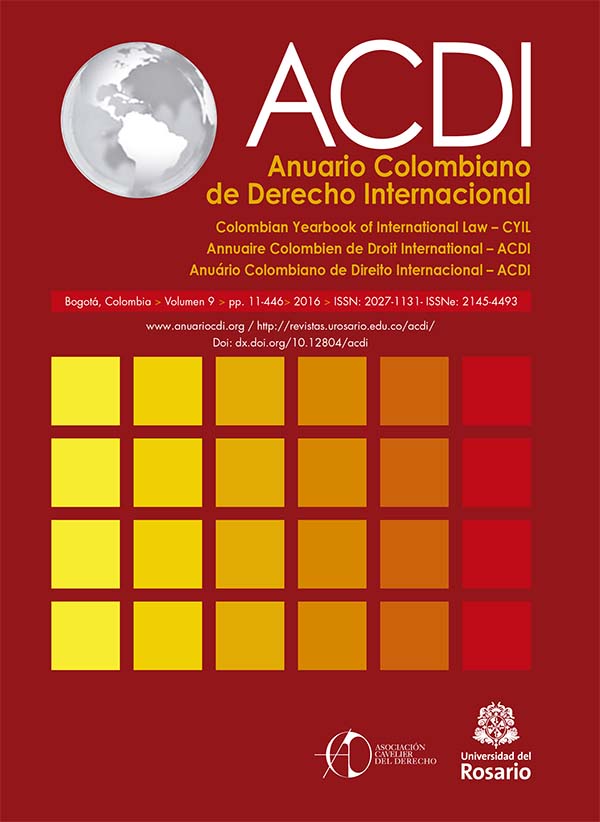¿Hay que hacer valer el macho en todas partes? El reto de las teorías feministas en el derecho de la paz y de la seguridad internacional
Barra lateral del artículo
Contenido principal del artículo
En un artículo fundador que apareció en 1991 intitulado «Feminist Approaches to International Law», Hillary Charlesworth, Christine Chinkin y Shelley Wright denuncian el derecho internacional como un «thoroughly gendered system». Estas autoras estiman, en efecto, que la dominación masculina se puede identificar tanto en el contenido como en la estructura de toda una serie de reglas del derecho internacional. El presente artículo busca establecer una evaluación de esta hipótesis con relación a los discursos y a la reglas del derecho de la paz y de la seguridad internacional. En el análisis, y especialmente con relación a la Resolución 1325 de 2000 y lo que ha sucedido con posterioridad con las teorías feministas, aparecen estas como un motor de cambio en la retórica, pero también, en el largo plazo, en la práctica. En contraposición, estas teorías muestran ciertos límites cuando pretenden denunciar, más allá de la violación de los derechos individuales de la mujer, la ‘masculinidad’ de las reglas que constituyen el jus contra bellum.
Descargas
Olivier Corten, Université libre de Bruxelles
Professeur à l’Université libre de Bruxelles, Centre de droit international et de sociologie appliquée au droit international
Ouvrages
Bethke Elshtain, J. & Tobias, S. (Ed.), Women, Militarism & War. Essays in History, Politics, and Social Theory, Maryland, Rowman & Littlefield, 1990.
Bethke Elshtain, J., Women and War, Chicago, Univ. Chicago Press, 1987.
Buss D. & Manji A. (Ed.), International Law. Modern Feminist Approaches, Oxford, Hart Publ. 2005.
Charlesworth, H. & Chinkin, C., The Boundaries of International Law. A Feminist Analysis, Manchester, Manchester University Press, 2000.
Charlesworth, H., Sexe, genre et droit international, Paris, Pedone, collection doctrine(s), 2013.
Randolph Higonnet, M., Michel, S., Jenson, J. & Collins Weitz, M., Behind the Lines. Gender and the Two World Wars, New Haven, Yale Univ. Press, 1987.
Ruth H., Women and the Use of Military Force, Boulder & London, Lynne Rienner Publishers, 1993.
Articles
Barnes, K., « The evolution and implementation of UNSCR 1325: an Over-view » in Olonisakin, F., Barnes, K. & Eka, I. (Eds.), Women, Peace and Security. Translating Policy into Practice, New York, Routledge, 2011, pp. 15-34.
Charlesworth, H. & Chinkin, C., « Sex, Gender and September 11 », AJIL, 2002, pp. 600-605.
Charlesworth, H. & Chinkin, C., « The Gender of Jus Cogens », Human Rights Quarterly, 1993, pp. 67-69.
Charlesworth, H., « Alieneting Oscar ? Feminist Analysis of International Law » in D.G. Dallmeyer (Ed.), Reconceiving Reality: Women and International Law, Washington, ASIL, 1993, pp. 1-18.
Charlesworth, H., « Feminist Critiques of International Law and their Critics », Thirld World Legal Studies, 1994, pp. 1-16.
Charlesworth, H., « Feminist Methods in International Law », AJIL, 1999, pp. 379-394.
Charlesworth, H., « Feminist Reflections on the Responsibility to Protect », Global Responsibility to Protect, 2010, pp. 232-249.
Charlesworth, H., « The sex of the State in International Law » in N. Naf-fine & R. Owens (Eds.), Sexing the Subject of Law, Sidney, Law Book Co, 1997, pp. 251-268.
Charlesworth, H., « Women and International Law », Australian Feminist Studies, 1994, pp. 115-128.
Charlesworth, H., Chinkin, C. & Wright, S., « Feminist Approaches to International Law », AJIL, 1991, pp. 613-645.
Charleworth, H., « The Missing Voice: Woman and the War in Iraq », Oregon Rev. I. L., 2005, pp. 5-15.
Chinkin, C. & Charlesworth, H., « Building Women into Peace: the inter-national legal framework », Thirld World Quarterly, 2006, pp. 937-957.
Chinkin, C., « A Gendered Perspective to the international use of force », Australian YIL, 1992, pp. 279-293.
Engle, K., « Calling in the Troops: The Uneasy Relationship among Women’s Rights, Human Rights and Humanitarian Intervention », Harvard Human Rights Journal, 2007, vol. 20, pp. 189-226.
Gardam, J. G., « Femmes, droits de l’homme et droit international hu-manitaire », Revue internationale de la Croix Rouge, 1998, pp. 449-462.
Haq, K., « Human Security for Women » in Tehranian, M. (Ed.), Worlds Apart: Human Security and Global Governance, London, I.B.Tauris Publishers, 1999, pp. 1-12.
Jones, J. R. W, « Composition of the Court » in Cassese, A., Gaeta, P., Jones, John R. W. (Ed.), The Rome Statute of the International Criminal Court: A Commentary, Oxford, OUP, 2002, pp. 235-267.
Krill, F., « La protection de la femme dans le droit international humanitaire », Revue internationale de la Croix Rouge, 1985, pp. 343-370.
MacKinnon, C. A., « Women’s September 11th: Rethinking The Interna-tional Law of Conflict », Harvard I. L. Jnal, 2006, pp. 9-14.
Orford, A., « Feminism, Imperialism and the Mission of International Law », Nordic JIL, 2002, pp. 275-296.
Orford, A., « Muscular Humanitarianism: Reading the Narratives of the New Interventionism », EJIL, 1999, pp. 679-711.
Otto, D., « The Security Council’s Alliance of Gender Legitimacy: The Symbolic Capital of Resolution 1325 » in Charlesworth, H. & Coi-caud, J.-M. (Ed.), Faultines of International Legitimacy, Cambridge, Cambridge Univ. Press, 2010, pp. 239-276.
Ubeda-Saillard, M., « Article 8 » in Cot, J.P., Forteau M., Pellet A. (Dir.), La Charte des Nations Unies, 3ème éd., Paris, Economica, 2005, pp. 603-630.
Von Schorlemer, S. « Article 8 » in Simma, B. et al. (Ed.), The Charter of the United Nations, 3nd ed., Oxford, OUP, 2012, pp. 416-444.
Detalles del artículo
Los autores conservan los derechos de autor y garantizan a la revista el derecho de ser la primera publicación del trabajo al igual que licenciado bajo una Creative Commons Attribution License que permite a otros compartir el trabajo con un reconocimiento de la autoría del trabajo y la publicación inicial en esta revista.







